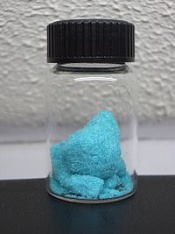Our kits are currently being reviewed and updated by a team of collaborative, innovative and interdisciplinary educators who wish to enhance the educational opportunities for students. These dedicated teachers are members of CRISP Collaborative Science for All (CCSA) as well as local educators.
Click to see the SCSU CRISP Module Template used by CCSA for improving and updating the CRISP demos and kits. Each kit page offers a CRISP developed teacher module and CRISP aligned standards (both NGSS and CCSS)
Kit Request form

Cupric Chloride courtesy of Wikipedia
This lab investigates different surface areas for the same material on the reaction rate speed. Reaction time is another phenomenon that changes at between macroscale and nanoscale. The greater the surface-to-volume ratio the reacting substances have, the faster the reaction time. Nanosized groups of particles are so small that they have a very high surface area to volume ratio, and thus react so quickly that precise measurements of time are difficult.
Adapted from Nanosense
Subject(s):
Volume and Reaction Rates, Size, Measurement
Objectives:
Students will develop an activity/procedure to demonstrate the effect of varying surface area to volume ratios of the same materials on the rate of reaction.
Materials in this kit:
- Copper (ll) Chloride Dihydrate [CuCl2 • 2H2O] crystals (MSDS in kit & below)
- Teaspoon (4)
- Glass stirring rod (4)
- 100 mL beakers (8)
- Aluminum foil,2 inches x 2 inches (8)
- Tongs (4)
- Paper towels and a solid waste disposal bottle
- Clock, timer, or watch with a second hand display
Suggestions for the Teacher:
Things to talk about:
What do you think is the relationship of the surface area to volume ratio of the reactants and the reaction time?
Research and organize enough information that can help you to answer the question [for example, what is reaction time, what is surface to volume ratio, etc.).
Safety:
- Wear goggles during this lab investigation.
- Don’t eat or drink anything at your lab station.
- Do not flush solution into the drain. Follow teacher instructions.
- Use caution when handling glassware.
- Cu2+ is a heavy metal and must be disposed of properly according to state and federal regulations.
Additional Resources:
Surface Area to Volume_Teacher
Surface Area to Volume_Student
Copper-II-Chloride Dihydrate- MSDS
STEM Careers:
Chemist
Biologist
Molecular Biologist
Biochemist
Toxicologist
Environmental Scientist
Materials Scientist
Metallurgist
Environmental Engineer
Materials Scientist
Researcher
Standards:
How do science and technology affect the quality of our lives?
9.8 - The use of resources by human populations may affect the quality of the environment.
9.9 -Some materials can be recycled, but others accumulate in the environment and may affect the balance of the Earth systems.
New technologies and changes in lifestyle can have positive and/or negative effects on the
10.1 - Fundamental life processes depend on the physical structure and the chemical activities of the cell.
D lNQ.1 - ldentify questions that can be answered through scientific investigation.
D lNQ.3 - Formulate a testable hypothesis and demonstrate logical connections between the scientific concepts guiding the hypothesis and the design of the experiment.
